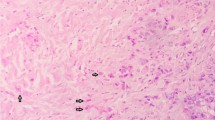Abstract
Purpose
To determine the pattern and significance of tumour budding among colorectal carcinoma (CRC) Nigerian patients using the 2016 International Tumour Budding Consensus Conference (ITBCC) guidelines.
Methods
H&E-stained slides of resected CRC at the University College Hospital and a private laboratory, both in Ibadan, Nigeria, from January 2008 to December 2017 were reviewed. Patient age, gender, tumour size and location were obtained from the surgical pathology records. Tumours were graded and staged according to the 2010 WHO and the 2017 UICC protocols, respectively. Tumour budding was determined at × 20 objective lens magnification with a 20-mm eyepiece field number diameter. Descriptive, Mann-Whitney U and chi-square test statistics were applied using SPSS 20; p < 0.05 was considered significant.
Results
Ninety-six cases were included in this study. Fifty-one (53.1%) showed tumour budding. Tumour bud count was low (0–4) in 66 (68.8%), intermediate (5–9) in 12 (12.5%) and high (≥ 10) in 18 (18.8%) tumours. Four tumours had pT1 stage, 35 pT2, 37 pT3 and 20 pT4. Forty-three (44.8%) tumours were lymph node–positive, and 10 (10.4%) had metastasis. Patients’ age and tumour size distribution were similar in the tumour budding and non-budding groups (52.4 ± 17.1/58.5 ± 13.9 years and 6.6 ± 2.9/6.6 ± 2.8 cm, respectively). There was significant association between tumour budding and tumour grade (p < 0.008), pT stage (p < 0.000), lymphovascular permeation (p < 0.000), perineural invasion (p < 0.003) and nodal status (p < 0.034), but not with gender (p = 0.588), metastasis (p = 0.327) and TNM group-stage (p = 0.062).
Conclusion
Tumour budding frequency is high among our CRC patients and is associated with poorer prognostic factors.

Similar content being viewed by others
Change history
21 February 2020
The original version of this article unfortunately contained a mistake. In Table 2, the number 36 under “N” should be 96 and “Tumour size in cm (range)” should read “Tumour size in cm.”
References
Bray F, Ferlay J, Soerjomataram I, Seigel RL, Torre LA, Jemal A. Global cancer statistics 2018 : GLOBOCAN estimates of incidence and mortality worldwide for 36 cancers in 185 countries. CA Cancer J Clin. 2018;68:394–424.
Allemani C, et al. Global surveillance of cancer survival 1995–2009 : analysis of individual data for 25 676 887 patients from 279 population-based registries in 67 countries ( CONCORD-2 ). Lancet. 2015;385(9972):977–1010.
Brierley JD, Gospodarowicz MK, Wittekind C. Colon and Rectum. In: TNM Classification of Malignant Tumours. 8th ed: Wiley Blackwell; 2017. p. 84–8.
Mitrovic B, Schaeffer DF, Riddell RH, Kirsch R. Tumor budding in colorectal carcinoma : time to take notice. Mod Pathol. 2012;25(10):1315–25.
Rogers AC, et al. Systematic review and meta-analysis of the impact of tumour budding in colorectal cancer. Br J Cancer. 2016;115(7):831–40.
Beaton C, Twine CP, Williams GL, Radcliffe AG. Systematic review and meta-analysis of histopathological factors influencing the risk of lymph node metastasis in early colorectal cancer. Color Dis. 2013;15:788–97.
Lugli A, Karamitopoulou E, Zlobec I. Tumour budding : a promising parameter in colorectal cancer. Br J Cancer. 2012;106(11):1713–7.
De Smedt L, Palmans S, Sagaert X. Tumour budding in colorectal cancer : what do we know and what can we do? Virchows Arch. 2016;468:397–408.
Lugli A, et al. Recommendations for reporting tumor budding in colorectal cancer based on the International Tumor Budding Consensus Conference ( ITBCC) 2016. Nat Publ Gr. 2017;30(9):1299–311.
Barel F, et al. Histopathological factors help to predict lymph node metastases more efficiently than extra-nodal recurrences in submucosa invading pT1 colorectal cancer. Sci Rep. 2019;9:1–12.
Demir A, Alan O. Tumor budding for predicting prognosis of resected rectum cancer after neoadjuvant treatment. World J Surg Oncol. 2019;6:1–8.
Gonzalez RS, Cates JM, Washington K. Associations among histologic characteristics and patient outcomes in colorectal carcinoma with a mucinous component. Histopathology. 2019;74(3):406–14.
Brockmoeller SF, et al. Predicting systemic spread in early colorectal cancer: can we do better? World J Gastroenterol. 2019;25(23):2887–97.
Hamilton SR, et al. Tumours of the colon and rectum. In: WHO classification of tumours of the digestive system. 4th ed. Lyon: IARC; 2010. p. 131–82.
IBM SPSS Statistics for Windows, version20. IBM Corp. New York: Armonk; 2011.
Zlobec I, Lugli A. Epithelial mesenchymal transition and tumor budding in aggressive colorectal cancer : tumor budding as oncotarget. Oncotarget. 2010;1(7):651–61.
Zhang Q, Wang L, Huang D, Xu M, Weng W, Ni S, et al. Pathological risk factors for lymph node metastasis in patients with submucosal invasive colorectal carcinoma. Cancer Manag Res. 2019;11:1107–14.
Konishi T, et al. Poorly differentiated clusters predict colon cancer recurrence: an in-depth comparative analysis of invasive-front prognostic markers. Am J Surg Pathol. 2019;42(6):705–14.
Author information
Authors and Affiliations
Corresponding author
Ethics declarations
The Helsinki guidelines for biomedical research and institutional guidelines on studies in human subjects were followed in this study. Ethical approval was obtained from the University of Ibadan/University College Hospital Ibadan Nigeria ethical committee with IRB No.: UI/EC/17/0190. All data were completely anonymized.
Conflict of Interest
The authors declare that they have no conflict of interest.
Additional information
Publisher’s Note
Springer Nature remains neutral with regard to jurisdictional claims in published maps and institutional affiliations.
Rights and permissions
About this article
Cite this article
Ezenkwa, U.S., Ogun, G.O., Bamiro, O.O. et al. Pattern and Significance of Tumour Budding in Colorectal Carcinomas Using ITBCC Guidelines: a Low Resource Setting Practice Observation. J Gastrointest Canc 51, 1018–1023 (2020). https://doi.org/10.1007/s12029-020-00365-4
Published:
Issue Date:
DOI: https://doi.org/10.1007/s12029-020-00365-4




